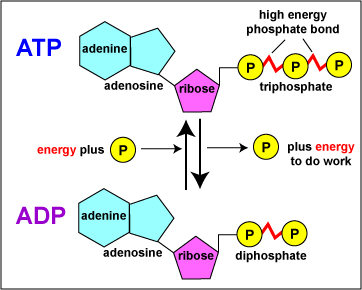Fig. 1: ATP Cycle

To trap energy released from catabolic
chemical reactions, the cell uses that released energy to attach a phosphate
group onto ADP (adenosine diphosphate) to make ATP (adenosine triphosphate).
Thus, energy is trapped and stored in high-energy phosphate bonds. To obtain
energy to do cellular work, the cell enzymatically removes the third phosphate
from ATP thus releasing the stored energy and forming ADP and phosphate once
again.
Illustration of ATP Cycle .jpg by Gary E. Kaiser, Ph.D.
Professor of Microbiology,
The Community College of Baltimore County, Catonsville Campus
This work is licensed under a Creative Commons Attribution 4.0 International License.
Based on a work at https://cwoer.ccbcmd.edu/science/microbiology/index_gos.html.

Last updated: Feb., 2021
Please send comments and inquiries to Dr.
Gary Kaiser
